Theresa May will soldier on as a broken-backed Prime Minister facing the prospect of her government collapsing at any moment.
She will become a “caretaker PM” – forming a feeble administration with the help of the Democratic Unionist Party and seek to run the country on a day-to-day basis.
Let’s be clear: the British government could fall on any single vote on any single night.
Worse still, she will become bogged down in the Lords, MPs warn.
This is because Peers will feel no reason to accept the “Salisbury Convention” which effectively guarantees support for manifesto commitments in a winning party’s General Election campaign.
She faces two enormous challenges: staving off a leadership challenge from her own Party, and successfully negotiating Britain’s exit from the European Union while ensuring her government doesn’t fall.
Cabinet ministers were this morning describing Mrs May’s decision to continue as the “least unpalatable of all unpalatable options”.
Intriguingly, no minister has emerged either to support her staying or calling for her head.
The implications of the Conservative Party’s General Election implosion are only just being considered by the most senior figures in British politics.
Immediately she must appoint a government with significantly different figures than she had intended.
She will have to balance the Cabinet as much as is possible, with Brexiteers and Remainers taking equal power.
Chancellor Philip Hammond is now likely to stay.
But she will come under immense pressure to dispense one or both of her chiefs of staff, who are already carrying the blame for Thursday’s catastrophe.
Many are already expecting that there will be no prospect of Britain paying off its deficit in the medium term.
Indeed, the chances are that Mrs May will have to open the public purse strings to try and keep millions of disgruntled voters at bay.
She will face enormous demands from public sector workers for an end to pay freezes. And she will have little ability to say “no”.
Teaching and health unions may well be the first to move, but expect similar demands from fire and police unions and others.
On Brexit, she will face enormous pain.
The 60 or so hardcore Brexiteers on her backbenches will push for a complete exit from the customs union and single market with no recourse to the European Court of Justice.
But the Remainers in her party will stand firm. She has no room to manoeuvre in any Commons vote. So remain MPs will still block their Brexit-supporting colleagues’ demands.
Mrs May will have to draw up policies for a Queen’s Speech – focusing on counter-terrorism, and the Great Repeal Bill.
But it will have to be empty on detail so she can force it through the Commons and then the Lords where there will be pitched battles.
And then there’s her leadership.
It is beyond doubt that senior figures in her Party will have an eye to the succession. There are already talks going on in some camps.
She may try to position herself as a caretaker until March 2019, offering a leadership change beyond then once Britain leaves the EU.
That would pave the way for a General Election in the summer of 2019 with the new Prime Minister presiding over Britain’s new deal with Brussels and the rest of the world.
But she would be relying on a lot of good will. The Conservative Party is utterly ruthless when it comes to choosing a leader.
Perhaps her greatest hope is making it clear to Tories that a leadership contest now would lead to a collapse of her government, a fresh General Election and a Jeremy Corbyn Premiership.

